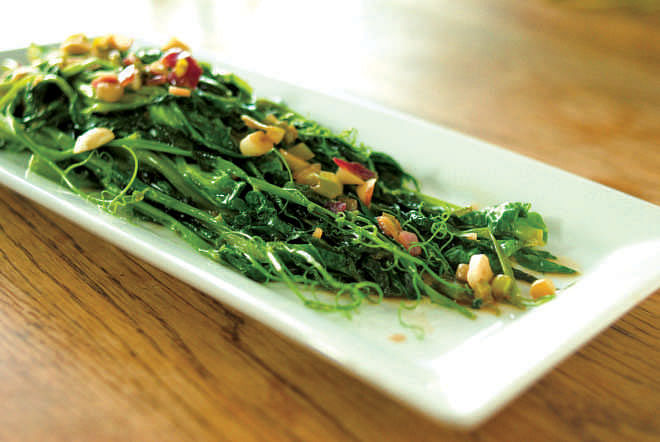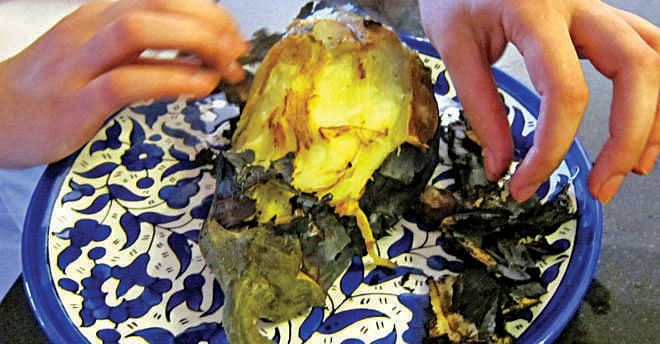ONE FOR THE veggies
ONE FOR THE veggies

Pea shoots stir-fry
Pea shoots, or motor shaak, are the tips of the vines and the top set of leaves of the pea plant. They are considered a "shaak". Green leafy vegetables are typically nutrient-dense. This means that for very few calories (5 per cup) you get large amounts of vitamins and minerals. Pea shoots are harvested after just 2-4 weeks, when the leaves are tender, young and literally bursting with a distinctive flavour. Look for pea shoots at your local vegetable market in winter; their season is rather short.
Choose shoots that include the top pair of small leaves (the tip), delicate tendrils attached to the young stem, and maybe a few larger leaves or even blossoms. Choose ones that are bright green and undamaged. Pea shoots are fragile and best used within one to two days of harvesting. Pea shoots can be eaten raw in your salad or lightly cooked.
Besides potassium, folate, vitamin C, thiamine, vitamin A, riboflavin, vitamin E, vitamin B-6, vitamin K and fibre, pea shoots are packed full of carotenes -- strong antioxidants that protect cells from damage and help prevent diseases. Pea shoots also contain valuable phytochemicals such as lignins, quercetin, and caffeic acid. Researchers believe these substances help prevent cancer in different ways and have other beneficial health effects.
-Data collected from the Japanese Standard Tables of Enjoying Pea Shoots.
Ingredients
4 cups or 1 bunch of pea shoots (motor shaak)
10 dry red chillies, charred and crushed
1 red onion, chopped
2 garlic cloves, crushed
1½ tsp salt
1 tbsp mustard oil
Method
Heat oil in a wok, lob in the onions, and sauté until translucent. Add the following: garlic and pea shoots. Toss lightly about 20 seconds, and then add salt. Cover and heat just until wilted. The water clinging to the damp shoots is enough to steam them. Sprinkle the crushed red chilli on top. Serve with steamed rice.

Pumpkin flower deep fried
The pumpkin (Cucurbita pepo) plant has hairy yellow flowers 6 to 8 cm wide and along with the banana flower and the sajna flower, the three blossoms are cooked and eaten in East India.
Ingredients
20 pumpkin flowers
1 tsp salt
¼ tsp baking powder
4 eggs
Oil for deep-frying
1 tbsp arrowroot
Method
Break and separate egg white and yolk. Lightly beat the yolk with a wire whisk. Fluff up the egg white with an electric wire beater until frothy (the test of right consistency: the egg-white does not fall off the bowl when turned upside down). Fold the yolk into the egg whites and whisk lightly to mix. Make a light batter by combining the following: arrowroot, salt, baking powder and ¼ cup water. Blend this batter with the beaten eggs. Whisk till smooth. Hold the stem of the pumpkin flowers (kumro phool) and dip the flowers in batter, gently shake off extra batter and deep-fry in hot oil until crisp.
Banana pith
The pith (soft white centre) of the banana plant, called 'thor', relished as a novelty item may have been adopted as a vegetable of last resort, during trying times. In the urban scene 'thor' is a delicacy. It is cooked on its own, with other vegetables, daal or with 'shutki.' East Indians do great justice to the banana plant, eating its raw fruit, ripe fruit, its inflorescence (mocha) and its pith (thor) and finally its leaf is used as a wrapper to bake food, or as a serving plate.
Ingredients
30 cm long banana pith (thor)
1 tsp mustard paste
2 tbsp mustard oil
2 tbsp yoghurt
1 tsp mustard seeds
2 tsp salt
2 green chillies, slit
1 tsp sugar
Method
Finely chop pith (thor) and soak in an ample amount of salted water for 20 minutes. Remove the thread-like sap by stirring the pith with a wooden chopstick or a skewer. Get hold of as much of the sap as you can manage and discard. Fold the pith (thor) in muslin. Squeeze out excess water and drain well. Set aside.
Heat the oil in a wok to smoking point; toss in the mustard seeds and green chillies. As soon as the mustard seeds stop sputtering, chuck in the drained pith (thor). Sauté stirring all the time, for a few minutes, then add the following: mustard paste and yoghurt and salt and sugar. Cover with a lid and cook for a few minutes.
Pointed gourd dolma
In the European cuisine 'dolma' is an edible leaf (e.g. grape leaf or cabbage leaf) cooked with a filling of ground meat, herbs, or rice. In Bangladesh and West Bengal it is stuffed vegetables. The word Dolma (plural: dolmades), is from the Greek process of wrapping food in grape leaves, to cook. We term stuffed vegetables as dolma, because it is convenient to do so for stuffed leaves already had a name in Bangla: paturi.
40 Servings
Ingredients
40 (2kg) pointed gourd
8 tsp garam masala powder
2 tbsp ginger paste
2 tbsp sugar
250g split peas (boot'er daal) soaked, boiled and ground to a firm paste
1 tsp cumin seeds
4 tsp cumin powder
8 tbsp coconut grate (1/2-coconut)
1 cup coconut milk, 1st extract
2 cups coconut milk, 2nd extract
3 cups coconut milk, 3rd extract
1 kg yoghurt
10 green cardamom pods (gently cracked)
6 bay leaves (tejpata)
Paste of 15 green chillies
½ tsp turmeric powder
200g raisins
4 tsp red chilli powder
3 tsp salt
4 tbsp ghee
8 tbsp soya oil
Method
Scrape out the outer membrane of the potol's rind with a very sharp knife (do not peel the rind). Heat 6 tablespoons of oil in a wok; when hot, toss in the following: daal paste, 1 teaspoon salt, 1 tablespoon sugar, 1 tablespoon ginger, green chilli paste, 2 teaspoons red chilli, raisins, coconut grate, 4 teaspoons cumin powder and green cardamom.
Cook stirring and scraping constantly with a rubber spatula/wooden 'khunti', until the raw smell of ginger fades away, (say 5 minutes) and the mixture emits a beautiful aroma. Transfer cooked daal paste to a bowl and set aside.
Heat 2 tbsp oil in a wok; sprinkle with 1 tsp salt, stir and chuck in the potols. Sauté them until they are a few shades darker (overcooking will wrinkle the rind). Strain out the potols from the wok, and set aside to cool.
When potol reaches room temperature, top and tail them. With the tip of a sharp knife slash a lengthwise slit alongside the middle section of the potol. Press the potol from both ends to open up the slit. With a teaspoon scoop out the seeds and discard them.
Stuff the potols with the cooked daal paste, press to close the slit. Arrange them on a serving dish, the slashed side facing down. Pour the coco-sauce (recipe given below) over them, and serve.
Coco-sauce:
Heat ghee in a pan, toss in the following: bay leaves, cumin seeds, 1 tbsp sugar, 1 tsp ginger, turmeric powder, 2 tsp salt, 2 tsp red chilli. Sauté stirring vigorously until spice releases its flavour.
Pour in: yoghurt, coconut milk (1st, 2nd and 3rd extract). Mix up, bring it to a boil and cook for 5 minutes.
Pour sauce over the cooked potol. Sprinkle with garam masala.
Aubergine-yoghurt mash
Ingredients
1 kg aubergine
2 tbsp ghee
3½ tsp salt
4 red onions, chopped
1 tbsp onion, sliced
4 ripe tomatoes
10 green chillies, chopped
2 cups of yoghurt
1 tsp garam masala powder
Method
Singe the aubergine over an open flame. Turn frequently until their skins are completely charred. Rub off the burnt aubergine skin with a moist kitchen towel. Mash them with a potato masher, set aside. Plunge the tomatoes in boiling water, scoop them out after 2 minutes and place them in ice water.
Peel off the tomato skin, and chop tomatoes into small pieces. Discard the skin and seeds. Set tomato pieces aside.
Heat ghee in a wok; lob in the chopped onion and sauté until they are golden. Using a slotted spoon strain out onions and grind them with one-tablespoon of water into a smooth brown paste.
In a mixing bowl, merge the fried onion paste with the yoghurt. Whisk well and set aside. Into the ghee left behind in the wok, pour in: aubergine mash, yoghurt mélange, green chilli, tomato, sliced onion and salt. Mix up, and cook stirring for 5 minutes. Remove from heat, sprinkle with garam masala powder and stir to mix.